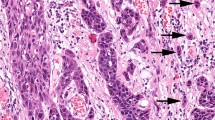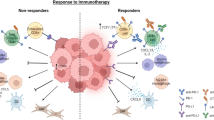Abstract
Background
The nature of the tumour microenvironment immune response in head and neck cancer patients has an important role in tumour development and metastasis, but it is unknown if this differs between cancer subsites or whether it is related to the peripheral immune response.
Methods
Immune cells (CD4, CD8, Foxp3) in head and neck squamous cell carcinoma tissue (HNSCC; n = 66), detected by immunohistochemistry, have been correlated with tumour subsite and immune cells in the peripheral circulation (CD4+CD25HighFoxp3+ Treg and CD4+ T cells), identified using flow cytometry.
Results
Oropharyngeal tumours had a greater number of infiltrating immune cells in both tumour and stroma compared with other subsites, but no difference was observed in the circulating levels. Immune cells in the stroma were positively related to those in the tumour with consistently higher levels in stroma. A strong relationship was found between the number of CD4+ and Foxp3+ cells but not between the number of CD8+ and Foxp3+ cells in the tumour. The number of Foxp3+ cells within the tumour was positively correlated with the percentage of circulating CD4+CD25High cells positive for Foxp3. Late stage laryngeal tumours showed a higher number of Foxp3+ lymphocytes compared with early stage malignancies, and oropharyngeal tumours had more CD4+ cells in node negative tumours compared with node positive ones.
Conclusion
The level of immune cell infiltration in head and neck squamous cell carcinoma appears to be subsite dependent residing primarily in the stroma and is likely to be dependent on the peripheral immune response.





Similar content being viewed by others
References
Parkin DM, Bray F, Ferlay J, Pisani P (2005) Global cancer statistics 2002. CA Cancer J Clin 55:74–108
Ang KK, Harris J, Wheeler R, Weber R, Rosenthal DI, Nguyen-Tân PF, Westra WH, Chung CH, Jordan RC, Lu C, Kim H, Axelrod R, Silverman CC, Redmond KP, Gillison ML (2010) Human papillomavirus and survival of patients with oropharyngeal cancer. N Engl J Med 363:24–35. doi:10.1056/NEJMoa0912217
Duray A, Demoulin S, Hubert P, Delvenne P, Saussez S (2010) Immune suppression in head and neck cancers: a review. Clin Dev Immunol. doi:10.1155/2010/701657
Whiteside TL (2010) Immune responses to malignancies. J Allergy Clin Immunol 125:S272–S283
Junker N, Kvistborg P, Køllgaard T, Pt Straten, Anderson MH (2012) Tumor associated antigen specific T-cell populations identified in ex vivo expanded TIL cultures. Cell Immunol 273:1–9. doi:10.1016/j.jaci.2009.09.045
Fridman WH, Pages F, Sautes-Fridman C, Galon J (2012) The immune contexture in human tumours: impact on clinical outcome. Nat Rev Cancer 12:298–306. doi:10.1038/nrc3245
deLeeuw RJ, Kost SE, Kakal JA, Nelson BH (2012) The prognostic value of FoxP3+ tumor-infiltrating lymphocytes in cancer: a critical review of the literature. Clin Cancer Res 18:3022–3029. doi:10.1158/1078-0432.CCR-11-3216
Hwang WT, Adams SF, Tahirovic E, Hagemann IS, Coukos G (2012) Prognostic significance of tumor-infiltrating T cells in ovarian cancer: a meta-analysis. Gynecol Oncol 124:192–198. doi:org/10.1016/j.ygyno.2011.09.039
Anz D, Eiber S, Sholtz C, Endres S, Kirchner T, Bourquin C, Mayr D (2011) In breast cancer, a high ratio of tumour-infiltrating intraepithelial CD8+ to FoxP3+ cells is characteristic for the medullary subtype. Histopathology 59:965–974. doi:10.1111/j.1365-2559.2011.04040.x
Pretscher D, Distel LV, Grabenbauer GG, Wittlinger M, Buettner M, Niedobitek G (2009) Distribution of immune cells in head and neck cancer: CD8+ T cells and CD20+ B-cells in metastatic lymph nodes are associated with favourable outcome in patients with oro- and hypopharyngeal carcinoma. BMC Cancer 9:292–302. doi:10.1186/1471-2407-9-292
Uppaluri R, Dunn GP, Lewis JS (2008) Focus on TILs: prognostic significance of tumour infiltrating lymphocytes in head and neck cancers. Cancer Immunol 8:16–25
Whiteside TL (2010) Inhibiting the inhibitors: evaluating agents targeting cancer immunosuppression. Expert Opin Biol Ther 10:1019–1035. doi:10(1517/14712598).2010.482207
Poschke I, Mougiakakos D, Kiessling R (2011) Camouflage and sabotage: tumor escape from the immune system. Cancer Immunol Immunother 60:1161–1171. doi:10.1007/s00262-011-1012-8
Hanahan D, Weinberg RA (2011) Hallmarks of cancer: the next generation. Cell 144:646–674. doi:10.1016/j.cell.2011.02.013
Alhamarneh O, Amarnath SMP, Stafford ND, Greenman J (2008) Regulatory T-cells: what role do they play in antitumour immunity in patients with head and neck cancer? Head Neck 30:251–261. doi:10.1002/hed.20739
Sakaguchi S, Miyara M, Costantino CM, Hafler DA (2010) FoxP3+ regulatory T cells in the human immune system. Nat Rev Immunol 10:490–500. doi:10.1038/nri2785
Green VL, Irune E, Prasai A, Alhamarneh O, Greenman J, Stafford ND (2012) Serum IL10, IL12 and circulating CD4+CD25high T regulatory cells in relation to long-term clinical outcome in head and neck squamous cell carcinoma patients. Int J Oncol 40:833–839. doi:10.3892/ijo.2011.1259
Lau KM, Cheng SH, Lo KW, Lee SA, Woo JK, van Hasselt CA, Lee SP, Rickinson AB, Ng MH (2007) Increase in circulating Foxp3+CD4+CD25(high) regulatory T cells in nasopharyngeal carcinoma patients. Br J Cancer 96:617–622. doi:10.1038/sj.bjc.6603580
Boucek J, Mrkvan T, Chovanec M, Kuchar M, Betka J, Boucek V, Hladikova M, Betka J, Eckschlager T, Rihova B (2010) Regulatory T cells and their prognostic value for patients with squamous cell carcinoma of the head and neck. J Cell Mol Med 14:426–433. doi:10.1111/j.1582-4934.2008.00650.x
Badoual C, Hans S, Rodriguez J, Peyrard S, Klein C, Agueznay Nel H, Mosseri V, Laccourreye O, Bruneval P, Fridman WH, Brasnu DF, Tartour E (2006) Prognostic value of tumor-infiltrating CD4+ T-cell subpopulations in head and neck cancers. Clin Cancer Res 12:465–472. doi:10.1158/1078-0432.CCR-05-1886
Loose D, Signore A, Bonanno E, Vermeersch H, Dierckx R, Deron P, Van de Wiele C (2008) Prognostic value of CD25 expression on lymphocytes and tumor cells in squamous-cell carcinoma of the head and neck. Cancer Biother Radiopharm 23:25–33. doi:10.1089/cbr.2007.0373
Briest F, Berndt A, Clement J, Eggeling F, Grimm S, Friedrich K (2012) Tumour-stroma interactions in tumorigenesis:lessons from stem cell biology. Front Biosci (Elite Ed) 4:1871–1887. doi:org/10.2741/509
Basanta D, Scott JG, Fishman MN, Ayala G, Hayward SW, Anderson ARA (2012) Investigating prostate cancer tumour-stroma interactions: clinical and biological insights from an evolutionary game. Br J Cancer 106:174–181. doi:10.1038/bjc.2011.517
Li H, Fan X, Houghton JM (2007) Tumor Microenvironment: the role of the tumour stroma in cancer. J Cell Biochem 101:805–815. doi:10.1002/jcb.21159
Alhamarneh O, Agada F, Madden L, Stafford N, Greenman J (2011) Serum IL10 and circulating CD4(+)CD25(high) regulatory T cell numbers as predictors of clinical outcome and survival in patients with head and neck squamous cell carcinoma. Head Neck 33:415–423. doi:10.1002/hed.21464
Vasievich EA, Huang L (2011) The suppressive tumor microenvironment: a challenge in cancer immunotherapy. Mol Pharm 8:635–641. doi:10.1021/mp1004228
Swartz MA, Lund AW (2012) Lymphatic and interstitial flow in the tumour microenvironment: linking mechanobiology with immunity. Nat Rev Cancer 12:210–219. doi:10.1038/nrc3186
Westra WH (2009) The changing face of head and neck cancer in the 21st century: the impact of HPV on the epidemiology and pathology of oral cancer. Head Neck Pathol 3:78–81. doi:10.1007/s12105-009-0100-y
Distel LV, Fickenscher R, Dietel K, Hung A, Iro H, Zenk J, Nkenke E, Büttner M, Niedobitek G, Grabenbauer GG (2009) Tumour infiltrating lymphocytes in squamous cell carcinoma of the oro- and hypopharynx: prognostic impact may depend on type of treatment and stage of disease. Oral Oncol 45:e167–e174. doi:10.1016/j.oraloncology.2009.05.640
Marur S, D’Souza G, Westra WH, Forastiere AA (2010) HPV-associated head and neck cancer: a virus-related cancer epidemic. Lancet Oncol 11:781–789. doi:10.1016/S1470-2045(10)70017-6
Hobbs CGL, Sterne JAC, Bailey M, Heyderman RS, Birchall MA, Thomas SJ (2006) Human papillomavirus and head and neck cancer: a systematic review and meta-analysis. Clin Otolaryngol 31:259–266. doi:10.1111/j.1749-4486.2006.01246.x
Kreimer AR, Clifford GM, Boyle P, Franceschi S (2005) Human papillomavirus types in head and neck squamous cell carcinomas worldwide: a systematic review. Cancer Epidemiol Biomarkers Prev 14:467–475. doi:10.1158/1055-9965.EPI-04-0551
Evans M, Powell NG (2010) The changing aetiology of head and neck cancer: the role of human papillomavirus. Clin Oncol 22:538–546. doi:10.1016/j.clon.2010.05.024
Hoffmann TK, Arsov C, Schirlau K, Bas M, Friebe-Hoffmann U, Klussmann JP, Scheckenbach K, Balz V, Bier H, Whiteside TL (2006) T cells specific for HPV16 E7 epitopes in patients with squamous cell carcinoma of the oropharynx. Int J Cancer 118:1984–1991. doi:10.1002/ijc.21565
Strauss L, Bergmann C, Gooding W, Johnson JT, Whiteside TL (2007) The frequency and suppressor function of CD4+CD25highFoxp3+T cells in the circulation of patients with squamous cell carcinoma of the head and neck. Clin Cancer Res 13:6301–6311. doi:10.1158/1078-0432.CCR-07-1403
Whiteside TL (2008) The tumour microenvironment and its role in promoting tumour growth. Oncogene 27:5904–5912. doi:10.1038/onc.2008.271
Liu F, Li Y, Ren M, Zhang X, Guo X, Lang R, Gu F, Fu L (2012) Peritumoral FOXP3+ regulatory T cell is sensitive to chemotherapy while intratumoral FOXP3+ regulatory T cell is prognostic predictor of breast cancer patients. Breast Cancer Res Treat 135:459–467. doi:10.1038/onc.2008.271
Mayer CT, Floess S, Baru AM, Lahl K, Huehn J, Sparwasser T (2011) CD8+FoxP3+ Tcells share developmental and phenotypic features with classical CD4+FoxP3+ regulatory T cells but lack potent suppressive activity. Eur J Immunol 41:716–725. doi:10.1002/eji.201040913
Roncarlo MG, Gregori S (2008) Is FOXP3 a bona fide marker for human regulatory T cells? Eur J Immunol 38:925–927. doi:10.1002/eji.200838168
Karanikas V, Speletas M, Zamanakou M, Kalala F, Loules G, Kerenidi T, Barda AK, Gourgoulianis KI, Germenis AE (2008) FoxP3 expression in human cancer cells. J Transl Med 6:19–26. doi:10.1186/1479-5876-6-19
Strauss L, Bergmann C, Whiteside TL (2007) Functional and phenotypic characteristics of CD4+CD25HighFoxp3+Treg clones obtained from peripheral blood of patients with cancer. Int J Cancer 121:2473–2483. doi:10.1002/ijc.23001
Schott AK, Pries R, Wollenberg B (2010) Permanent up-regulation of regulatory T-lymphocytes in patients with head and neck cancer. Int J Mol Med 26:67–75. doi:10.3892/ijmm_00000436
Chen KJ, Lin SZ, Zhou Z, Xie HY, Zhou WH, Taki-Eldin A, Zheng SS (2011) Selective Recruitment of regulatory T cell through CCR6-CCL20 in hepatocellular carcinoma fosters tumor progression and predicts poor prognosis. PLoS ONE 6:e24671. doi:10.1371/journal.pone.0024671
Gasparoto TH, de Souza Malaspina TS, Benevides L, de Melo EJ Jr, Costa MR, Damante JH, Ikoma MR, Garlet GP, Cavassani KA, da Silva JS, Campanelli AP (2010) Patients with oral squamous cell carcinoma are characterized by increased frequency of suppressive regulatory T cells in the blood and tumor microenvironment. Cancer Immunol Immunother 59:819–828. doi: 10.1007/s00262-009-0803-7
Strauss L, Bergmann C, Szczepanski M, Gooding W, Johnson JT, Whiteside TL (2007) A unique subset of CD4+CD25highFoxP3+T cells secreting interleukin-10 and transforming growth factor-B1 mediates suppression in the tumor microenvironment. Clin Cancer Res 13:4345–4354. doi:10.1158/1078-0432.CCR-07-0472
Acknowledgments
We would like to thank Mr Jose and other members of the head and neck surgical team in Hull for consenting the patients and collection of peripheral blood samples and Dr Laszlo Karsai and Karen Bedford for the identification and sectioning of the paraffin tissue blocks as well as helpful advice on tissue morphology. Invaluable statistical advice was obtained from Dr Victoria Allgar HYMS statistical consultancy, and finally, we gratefully acknowledge Yorkshire Cancer Research for financial support.
Conflict of interest
The authors declare that they have no conflict of interest.
Author information
Authors and Affiliations
Corresponding author
Rights and permissions
About this article
Cite this article
Green, V.L., Michno, A., Stafford, N.D. et al. Increased prevalence of tumour infiltrating immune cells in oropharyngeal tumours in comparison to other subsites: relationship to peripheral immunity. Cancer Immunol Immunother 62, 863–873 (2013). https://doi.org/10.1007/s00262-013-1395-9
Received:
Accepted:
Published:
Issue Date:
DOI: https://doi.org/10.1007/s00262-013-1395-9




